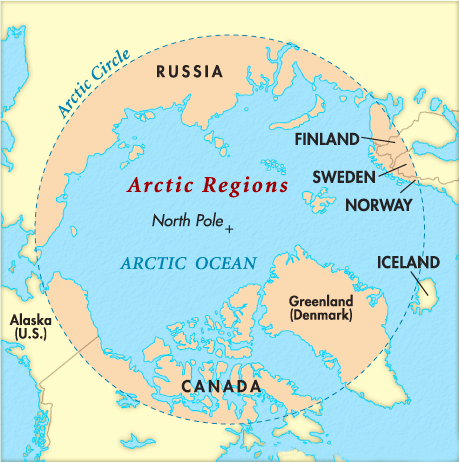Biodiversity & Environment
India's Maiden Winter Arctic Research
- 23 Dec 2023
- 5 min read
For Prelims: National Centre for Polar and Ocean Research (NCPOR), Indian Institute of Tropical Meteorology (IITM), Climate Change, Space Weather, Sea-Ice , Ocean Circulation Dynamics, Ecosystem, Himadri, Intergovernmental Panel on Climate Change, Inter Tropical Convergence Zone
For Mains: Significance of India's Winter Arctic Research, Arctic Region.
Why in News?
Recently, the Union Minister of Earth Sciences flagged off India’s first winter scientific expedition to Himadri, the nation's Arctic Research Station situated in Ny-Ålesund within the Norwegian archipelago of Svalbard in the Arctic.
- The first batch of the maiden Arctic winter expedition comprises researchers from the host National Centre for Polar and Ocean Research (NCPOR), Indian Institute of Technology (IIT) Mandi, Indian Institute of Tropical Meteorology (IITM) and Raman Research Institute.
What is the Importance of The Winter Arctic Scientific Expedition?
- Indian scientific expeditions to the Arctic during the winter will allow researchers to conduct unique scientific observations during polar nights, where there is no sunlight for nearly 24 hours and sub-zero temperatures.
- It opens more avenues for India to expand our scientific capabilities in Earth’s poles.
- This will aid in expanding understanding of the Arctic, especially climate change, space weather, sea-ice and ocean circulation dynamics, ecosystem adaptations, etc. which affect weather and climate in the tropics, including monsoons.
- India has operated a research base in the Arctic named Himadri since 2008, which has been mostly hosting scientists during the summer (April to October).
- Priority research areas include atmospheric, biological, marine, and space sciences, environmental chemistry, and studies on cryosphere, terrestrial ecosystems, and astrophysics.
- India will join a small group of countries that operate their Arctic research bases through the winter.
- In recent years, climate change and global warming research has been attracting scientists to the Arctic region.
What is the Impact of Warming on the Arctic?
- Temperatures in the Arctic region have risen by about 4 degree Celsius on average over the last 100 years 2023 was the warmest year on record.
- The extent of Arctic sea-ice has been declining at the rate of 13%/ decade, according to the Intergovernmental Panel on Climate Change.
- The melting sea ice can have global impacts reaching beyond the Arctic region.
- Rising sea levels can influence atmospheric circulation.
- An increase in tropical sea surface temperatures could lead to increased precipitation in the tropics, a shift in the Inter Tropical Convergence Zone and high chances of an increase in extreme rainfall events.
- Milder weather due to global warming could make the Arctic a more habitable and a less hostile place.
- There could be a rush to explore and exploit the Arctic’s resources, including its minerals, and countries will seek to control trade, navigation and other strategic sectors in the region.
Note
- Dakshin Gangotri in Antarctica was set up much earlier in 1983. Dakshin Gangotri is now submerged under ice, but India’s two other stations, Maitri and Bharti, are in use.
- Indian scientific expeditions to the Earth’s poles (the Arctic and the Antarctic) are facilitated under the PACER (Polar and Cryosphere) scheme of the MoES, solely through the aegis of the National Centre for Polar and Ocean Research (NCPOR), Goa, an autonomous institution of the MoES.
UPSC Civil Services Examination, Previous Year Question (PYQ)
Prelims
Q. The term ‘IndARC’, sometimes seen in the news, is the name of (2015)
(a) an indigenously developed radar system inducted into Indian Defence
(b) India’s satellite to provide services to the countries of Indian Ocean Rim
(c) a scientific establishment set up by India in Antarctic region
(d) India’s underwater observatory to scientifically study the Arctic region
Ans: (d)
Mains
Q.1 Why is India taking keen in resources of Arctic region? (2018)
Q.2 What are the economic significances of discovery of oil in Arctic Sea and its possible environmental consequences? (2015)







